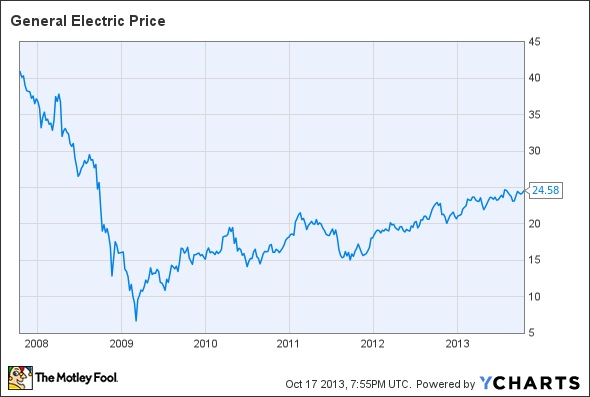The story of General Electric's (GE 0.20%) near-collapse in 2008 and subsequent turnaround sounds like a broken record at this point. Soaring debt levels crippled the company, Warren Buffett injected $3 billion through preferred shares, and slowly but surely the market regained confidence in GE's ability to fix its balance sheet.

A gas turbine. Source: GE.
While that's old news, many investors are unaware of the state of the company's various operations today. In short, what has driven GE's comeback to reach a stock price not seen in more than five years? Let's take a look.
A crushing blow, a steady revival
To provide perspective, GE's stock price fell by 75% between October 2007 and February 2009. It took more than four years to recoup half of the value lost in that short time frame. GE's still lifting itself out of a deep ditch, and so far the progress has been steady, not swift.
Along the way, GE's taken measures to reduce its dependence on financial products and rediscovered its manufacturing roots. GE Capital, the company's finance arm, balanced its checkbook, focused on plain vanilla banking, and announced plans to spin off consumer-focused lending activities that divert management's attention from core businesses.
But by no means has GE entirely reinvented itself. In fact, as of January, The New York Times noted that GE Capital as a stand-alone unit would be considered the fifth-largest commercial bank in America. If GE wants to look less like a bank with an industrial arm and more like the inverse, there's still plenty of work to be done. Let's look at the company's evolution over the last six years.
The key drivers of the General
From 30,000 feet, GE's various businesses look surprisingly well balanced today, at least when broken down among three core areas: finance (GE Capital), energy, and non-energy. Energy takes into account GE's power and water, oil and gas, and energy management businesses. The rest is considered "non-energy" for these purposes, and consists of, quite frankly, everything left over. While this category has evolved over time, it's mostly concerned with aviation health care and transportation.
In 2012 -- GE's most recent year-end -- GE Capital comes in at about 31% of revenue whereas energy and non-energy account for 35% and 34%, respectively. Taking a step back to 2007, the breakout looked quite different, however. GE Capital, energy, and non-energy businesses generated 38%, 44%, and 17% of respective revenue. The chart below illustrates this transformation of GE's key businesses.
What's evident from the data is that GE has gradually spread its resources more evenly across three key areas. GE Capital, in fact, has taken a backseat, but the decline on the top line -- only 7% -- is not so dramatic. The more telling story is about the rise of GE Energy. In just more than half of a decade, this unit has grown to a $51 billion behemoth.
GE Energy's average revenue growth rate of 13% is impressive, and a chart reflecting net income paints a similar story for this division.
From these charts, two noteworthy differences separate the revenue story from the net income one. First, the debt crisis that wreaked havoc on GE a few years ago had only a minor impact on the top-line of the company. Instead, GE Capital's roller-coaster ride took shape on the income statement. Highly levered financial instruments that generated outsized returns pre-crisis hit the bottom line hard when the company realized many were worthless.
That's a generalization of a highly complex event, to be sure, but it nonetheless played havoc on GE and forced the company to do some soul-searching in the process.
Secondly, GE Energy has grown to overshadow GE Capital, and this trend will persist. The net income breakout between these two might look the same today, but GE Capital is not the future. Instead, it's the rest of the business that will shape the GE of tomorrow, and GE Energy will be most critical to its success.
Foolish takeaway
Today, the thriving businesses at GE -- from gas turbines to energy distribution -- are quite different from the financial instruments that bolstered its bottom line in the past. Or, for that matter, the supercharger engines or X-ray machines that came before.
This latest evolution is just another illustration of GE's resiliency, which will be tested again and again. As GE completes what will technically be the 479th fiscal quarter for the company founded by Thomas Edison, make sure to pay attention to the things that matter during the earnings call.
Editor's note: A previous version of this article misstated past revenue breakout for GE Capital, energy, and non-energy businesses. The Motley Fool regrets the error.





